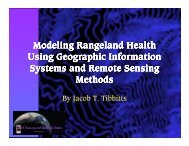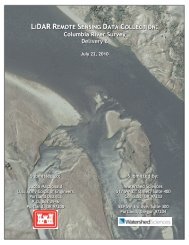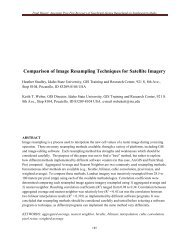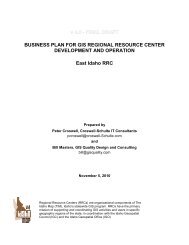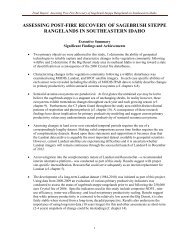A Multiscale Curvature Algorithm for Classifying Discrete Return ...
A Multiscale Curvature Algorithm for Classifying Discrete Return ...
A Multiscale Curvature Algorithm for Classifying Discrete Return ...
Create successful ePaper yourself
Turn your PDF publications into a flip-book with our unique Google optimized e-Paper software.
1036 IEEE TRANSACTIONS ON GEOSCIENCE AND REMOTE SENSING, VOL. 45, NO. 4, APRIL 2007Fig. 6. Shaded relief’s comparing different interpolators within MCC.(a) Ordinary Kriging. (b) Inverse distance weighting. (c) Triangular irregularnetwork. (d) TPS.bias using validation data less accurate than the LiDAR data[36]. If a representative validation sample were to be calculatedbased on the number of observations in the LiDAR, the numberof field samples required <strong>for</strong> 95% confidence intervals wouldbe virtually impossible to acquire [37], precluding many traditionalvalidation techniques.D. EvaluationLess understory vegetation and surface clutter will increasecertainty in the ground estimate, as demonstrated by the MonteCarlo simulations (Fig. 6). Including the LiDAR measurementerror in the total RMSE reported <strong>for</strong> the jackknife validationand Monte Carlo simulation results more honestly reflects thecumulative error in the estimate of ground elevation and moreconservatively assesses the accuracy of the derived DEM. TheLISA point pattern statistic provides an unbiased empiricalmethod <strong>for</strong> validating the classified ground points and quantifyingthe magnitude of identified errors. The results illustratethat potential commission errors are kept to a minimum(Figs. 4 and 7). Potential commission errors can vary from lowamplitude errors representing understory vegetation to entirenonground objects that the model fails to identify [3], [15].Some level of surface modulation is to be expected in <strong>for</strong>estedareas due to low understory vegetation, logs, stumps, and otherground debris [3].Commission and omission errors play an important role inLiDAR point classification. Omission errors are more difficultto observe and quantify than commission errors. However, if occurringin moderation omission errors has less influence on thequality of the resulting DEM. Generally, the results indicatedno severe biases in classified ground returns, either globally(Table III) or locally (Table IV, Figs. 4 and 7), suggesting thatMCC appropriately balanced commission and omission errors.The definition of “ground” is application and scale dependent,making it easy to disconnect the resolution of an interpolatedDEM surface estimate from the resolution of theLiDAR sample data. Block minimums are a clear example of aFig. 7. Cumulative RMSE from 1000 Monte Carlo simulations in (a) the<strong>for</strong>ested test area and (b) transitional <strong>for</strong>est test area. The RMSE range portrayedin the legend in (b) excludes two features (indicated by white arrows)that produced the RMSEs of ∼3m.LiDAR filtering strategy that can potentially disconnect a surfaceestimate from the resolution of the LiDAR sample data.Increasing the block size to identify the minimum groundheight effectively smoothes the data to a resolution that iscoarser than the LiDAR sampling frequency. This produces acontiguous grid of ground estimates that is consistently derivedacross the landscape, which may be convenient <strong>for</strong> some applications,but is decoupled from the highly variable nongroundsamples that are of primary interest <strong>for</strong> many applications. Themore sophisticated MCC classification strategy is most suited<strong>for</strong> <strong>for</strong>ested landscapes with or without complex terrain. TheMCC algorithm is efficient in that it maximizes the number ofclassified ground returns, making it an attractive algorithm <strong>for</strong>a variety of applications.VI. CONCLUSIONThe complex vertical arrangement of LiDAR data requiresan iterative processing approach to converge on an accuratesolution of identified nonground returns. The multiscale facetof the MCC model is perhaps its most useful innovation. Byaddressing topologic differences across scales [10], MCC effectivelyidentifies nonground returns in the vertical distributionof elevations in the LiDAR point cloud. The dynamic scaleand curvature tolerance parameters work in concert to account<strong>for</strong> changes in the topology of objects in the point cloud as





